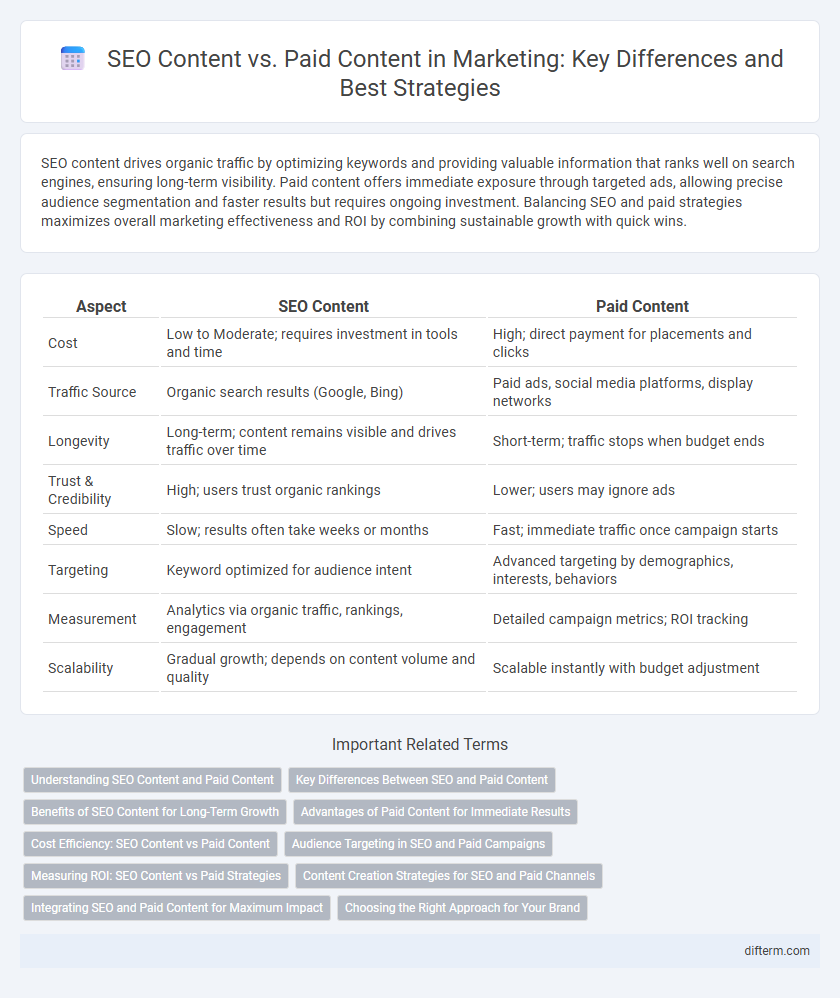SEO content drives organic traffic by optimizing keywords and providing valuable information that ranks well on search engines, ensuring long-term visibility. Paid content offers immediate exposure through targeted ads, allowing precise audience segmentation and faster results but requires ongoing investment. Balancing SEO and paid strategies maximizes overall marketing effectiveness and ROI by combining sustainable growth with quick wins.
Table of Comparison
| Aspect | SEO Content | Paid Content |
|---|---|---|
| Cost | Low to Moderate; requires investment in tools and time | High; direct payment for placements and clicks |
| Traffic Source | Organic search results (Google, Bing) | Paid ads, social media platforms, display networks |
| Longevity | Long-term; content remains visible and drives traffic over time | Short-term; traffic stops when budget ends |
| Trust & Credibility | High; users trust organic rankings | Lower; users may ignore ads |
| Speed | Slow; results often take weeks or months | Fast; immediate traffic once campaign starts |
| Targeting | Keyword optimized for audience intent | Advanced targeting by demographics, interests, behaviors |
| Measurement | Analytics via organic traffic, rankings, engagement | Detailed campaign metrics; ROI tracking |
| Scalability | Gradual growth; depends on content volume and quality | Scalable instantly with budget adjustment |
Understanding SEO Content and Paid Content
SEO content involves creating optimized material that improves organic search engine rankings through strategic keyword use, quality backlinks, and engaging user experiences. Paid content leverages targeted advertising platforms like Google Ads or social media ads to drive immediate traffic and conversions through paid placements. Understanding the distinct goals and performance metrics of SEO content versus paid content enables marketers to allocate budgets effectively and maximize return on investment.
Key Differences Between SEO and Paid Content
SEO content leverages organic search engine rankings by optimizing keywords, meta tags, and user intent to drive long-term, cost-effective traffic. Paid content depends on targeted advertising campaigns through platforms like Google Ads or social media to generate immediate visibility and controlled audience reach. Key differences include sustainability of traffic, cost structure, and reliance on algorithm-based ranking versus bidding models.
Benefits of SEO Content for Long-Term Growth
SEO content drives sustainable organic traffic by improving search engine rankings and establishing authority in niche markets. It generates compounding returns over time, reducing dependency on continuous ad spend unlike paid content. Investing in SEO content enhances brand credibility and delivers consistent, cost-effective leads for long-term business growth.
Advantages of Paid Content for Immediate Results
Paid content offers the advantage of delivering immediate visibility and traffic by targeting specific audiences through precise ad placements and demographics. It enables marketers to quickly test campaigns, measure ROI, and adjust strategies in real-time, ensuring optimal budget utilization. In contrast to SEO content, which requires time to build organic rankings, paid content drives instant engagement and accelerates lead generation.
Cost Efficiency: SEO Content vs Paid Content
SEO content offers superior cost efficiency by generating organic traffic over time without continuous expenses, unlike paid content that requires ongoing investment for sustained visibility. While paid content delivers immediate results, its cost per acquisition remains higher compared to SEO's long-term return on investment. Businesses prioritizing budget optimization benefit more from SEO's compounding effects on audience reach and engagement.
Audience Targeting in SEO and Paid Campaigns
SEO content leverages organic search data and keyword research to attract audiences actively seeking relevant information, ensuring high intent targeting over time. Paid campaigns use precise demographic, geographic, and behavioral targeting to deliver immediate exposure to specific audience segments, optimizing for conversions and reach. Combining these strategies enhances audience targeting by balancing sustainable organic visibility with scalable paid reach.
Measuring ROI: SEO Content vs Paid Strategies
Measuring ROI in SEO content involves tracking organic traffic growth, keyword rankings, and conversion rates over time, highlighting long-term value and cost-effectiveness. Paid content ROI is typically assessed through immediate metrics such as click-through rates, cost per acquisition (CPA), and return on ad spend (ROAS). Businesses should analyze these specific performance indicators to determine the optimal balance between sustainable organic reach and targeted paid campaigns.
Content Creation Strategies for SEO and Paid Channels
SEO content creation prioritizes keyword research, high-quality backlinks, and organic traffic growth by producing informative and relevant articles, blog posts, and landing pages optimized for search engines. Paid content strategies focus on targeted advertisements, sponsored posts, and paid placements to achieve immediate visibility and drive traffic through audience segmentation and budget allocation. Balancing SEO content with paid campaigns enhances overall marketing performance by combining sustainable organic reach with quick, measurable conversions.
Integrating SEO and Paid Content for Maximum Impact
Integrating SEO content and paid content strategies enhances overall marketing effectiveness by combining organic reach with targeted paid visibility, driving higher traffic and conversions. Utilizing SEO insights to inform paid content targeting ensures ad spend efficiency while enriching organic content with paid keyword data boosts search rankings. Leveraging analytics platforms to track combined campaign performance enables continuous optimization, maximizing ROI across both channels.
Choosing the Right Approach for Your Brand
SEO content builds long-term organic traffic through keyword optimization and valuable information, enhancing brand authority and cost efficiency over time. Paid content delivers immediate visibility and targeted reach via platforms like Google Ads or social media, ideal for time-sensitive campaigns and specific audience segments. Selecting the right approach depends on your brand's goals, budget, and timeline, often combining both strategies maximizes overall marketing effectiveness.
SEO Content vs Paid Content Infographic

 difterm.com
difterm.com